Abstract
Hydrogen energy is a clean, zero-carbon, long-term storage, flexible and efficient secondary energy. Accelerating the development of the hydrogen energy industry is a strategic choice to cope with global climate change, achieve the goal of carbon neutrality, and realize high-quality economic and social development. This study aimed to analyze the economic impact of introducing value-added services to the hydrogen energy market on hydrogen energy suppliers. Considering the network effect of value-added services, this study used a two-stage game model to quantitatively analyze the revenue of hydrogen energy suppliers under different scenarios and provided the optimal decision. The results revealed that (1) the revenue of a hydrogen energy supplier increases only if the intrinsic value of value-added services exceeds a certain threshold; (2) the revenue of hydrogen energy suppliers is influenced by a combination of four key factors: the intrinsic value of value-added services, network effects, user scale, and the sales strategies of rivals; (3) the model developed in this paper can provide optimal decisions for hydrogen energy suppliers to improve their economic efficiency and bring more economic investment to hydrogen energy market in the future.
1. Introduction
In response to global climate change, dozens of countries and regions have proposed “zero-carbon” or “carbon neutral” climate goals and introduced related policies in recent years [1]. According to the forecast of the International Energy Agency, the total amount of hydrogen energy application in 2050 is expected to reach 20% of the total energy consumption, which is equivalent to replacing fossil fuels with a calorific value of 78EJ per year, corresponding to a reduction of 6 Gt of CO2 emissions per year, equivalent to 18% of global emissions in 2019 [2]. It shows that the development of hydrogen energy is one of the effective ways to deal with climate problems and achieve “carbon peaking and carbon neutrality” [3].
As a kind of secondary energy, hydrogen energy has three main sources: fossil energy such as coal and natural gas, industrial by-product gas such as coke oven gas and Chlor-alkali tail gas, and electrolysis of water [4]. In addition, hydrogen energy can be produced by biomass energy, solar photocatalytic water splitting, and nuclear energy. Hydrogen produced by using renewable energy to power the electrolysis is also called green hydrogen, which is more environmentally sustainable. The global hydrogen market was valued at USD 187,517.3 Million in 2020, while the global hydrogen demand was around 90 Mt H24 [5]. According to a comprehensive research report by Business Wire, green hydrogen market was valued at USD 0.58 billion in 2020 and is projected to be worth USD 2.94 billion by 2025. Europe is the largest segment for green hydrogen market in terms of region and Asia-Pacific is the largest growing region [6]. With an installed global electrolyzer capacity of 290 MW, more than 40% is based in Europe with the next-largest capacity shares in Canada (9%) and China (8%). However, the market price of green hydrogen in the EU is now uncompetitive and stands at EUR 3.5–5.0 per kg, while China stands at 3.75–4 and the US stands at 4.00–4.25.
At present, the world’s major economies are conducting research on the application of hydrogen energy technology [7,8]. Wang Yanyu, Fu Guanyun and others mainly analyzed the research in hydrogen energy in the United States, which leads the world in the hydrogen fuel cell vehicle and hydrogen refueling stations [9,10,11]. Xia Fengjie and others analyzed the national hydrogen energy strategy in Germany, whose main hydrogen energy layout is concentrated in the transportation, aviation, steel, and chemical industries [12]. Ding Man, Wang Lin, and others comprehensively analyzed the development of hydrogen energy applications in Japan and South Korea [13,14,15,16]. Hartly and others analyzed Australia’s advantages in developing the hydrogen energy industry [17]. Andreasen and others hoped to consider approving a basket of different hydrogen energy applications and configurations to support “open” rather than “closed” innovation and development [18]. This portfolio-funding strategy enables suppliers to experiment, diversify and innovate from the ground up. The research on the hydrogen energy industry mainly focuses on green hydrogen production [19,20,21], hydrogen storage systems, and transportation (hydrogen fuel cell research and development and hydrogen refueling station construction). Alagan Muthurasu and others considered the importance of designing an efficient, cost-effective, and stable electrocatalyst for the water-splitting process to produce hydrogen [22,23]. Huo Xianxu and others summarized the key technologies of existing hydrogen storage systems [24]. Wan Chao and others provided a novel and efficient strategy for designing efficient catalysts to drive the hydrogen evolution from Formic acid [25]. Ren Zhuanghe and others presented recent research progress of hydrogen storage properties of NaAlH4 modified by Ti-based catalysts [26]. Burkhardt and others considered the specific environmental impact to produce, compress, and transport hydrogen and conducted a life cycle assessment of the hydrogen refueling station built and operated in Berlin [27]. Calculation results revealed that using the generated hydrogen for power can reduce greenhouse gas emissions by 86–89%. Xu Shisen and others made a general analysis of the main types of hydrogen as a fuel in the power industry [28,29]. Compared with other forms of energy, hydrogen does not have a comparative advantage economically for the time being due to the expensive production cost [30]. In the future, with the large-scale development of renewable energy construction projects dominated by wind and light, electrolysis of green hydrogen will become the main source of hydrogen energy [31,32]. Hosseini and others pointed out that since the cost of electricity plays a critical role in the price of hydrogen, to generate carbon-free hydrogen from solar and wind energy at a price competitive with fossil fuels, the cost of electricity should be four times lower than the retail price of electricity [33,34].
The China Hydrogen Energy Alliance predicts that hydrogen energy will account for about 10% of China’s energy system by 2050, with an annual economic output of more than 10 trillion yuan [35]. However, hydrogen energy production and consumption at the commercial level has not yet been formed. In addition to technical reasons, the lack of investment in hydrogen industry is the main reason at the economic level, and the key is that there is no hydrogen energy market yet, thus no effective market incentive can be formed. Therefore, this paper considers the introduction of value-added services in the hydrogen energy market, such as recycling of hydrogen fuel cells, retrofitting of hydrogen energy equipment, and consulting services, in order to improve the economic efficiency of hydrogen energy suppliers and to activate the hydrogen energy investment market. Value-added services were first originated from the telecommunication industry in the 1980s. Soinio and others argued that with the increase of service types and the improvement of service theoretical framework in the previous service models of SMEs, value-added services should also become a separate service system for in-depth analysis [36]. Dan Bin and others discussed the competition of value-added services from the perspective of channel supply chain and concluded that providing differentiated value-added services to customers has now become an emerging field of competition among enterprises, which can effectively expand the market demand [37,38,39]. Dou Guowei and others argued that unilateral investment can affect the utility of users and thus the demand and profit of the platform when considering the network externalities of the market [40,41,42]. Therefore, the importance of value-added services is self-evident for emerging markets, and it will be of great significance to analyze the role of value-added services in the hydrogen energy market.
2. Methodology
2.1. Model Structure
Since the hydrogen energy market is an emerging market, there are no specific regulations in terms of market entry rules and trading mechanisms. As shown hypothetically in Figure 1:
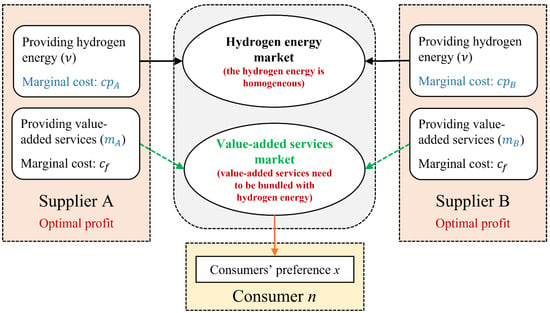
Figure 1.
Model structure.
- (1)
- There are only hydrogen energy suppliers A and B in the hydrogen energy market, and both suppliers are capable of providing hydrogen energy and value-added services. The market always has positive demand for suppliers A and B, which means it is fully covered by suppliers A and B at all times.
- (2)
- The hydrogen energy of the two suppliers is homogeneous. The intrinsic value of hydrogen energy is ν, but the marginal cost and the intrinsic value of value-added services are different. The marginal cost of value-added services is , the same for suppliers A and B.
- (3)
- The value-added services need to be bundled with hydrogen energy, which means the value-added services are not compatible.
- (4)
- Because the intrinsic value of value-added services is different, consumers with different preferences will make their own choices. Two suppliers are assumed to be located at two ends of a Hoteling line of length 1, that is, , and x is a random variable uniformly distributed within the line, representing the degree of consumer preference [43]. When products or services fail to meet consumers’ expectations, the utility loss will occur. Assuming that the unit utility loss is t, the utility loss for the consumer with preference x who chooses supplier A is , and for consumers who chooses supplier B. Here, t also represents consumers’ sensitivity to differences in services [44].
- (5)
- The total consumer number of hydrogen energy is N. The demand for hydrogen energy and value-added services is in unit demand.
2.2. Sales Strategy
In the hydrogen energy market, hydrogen energy suppliers A and B independently decide to provide value-added services. They implement the pricing strategies through a two-stage game model.
In the first stage, the two hydrogen energy suppliers simultaneously choose the sales strategy to provide value-added services. Therefore, the following four strategy situations will emerge., as shown in Table 1. SS situation: the two hydrogen energy suppliers both provide value-added services. SN situation: supplier A provides value-added services while supplier B does not. NS situation: supplier A does not provide value-added services while supplier B does. NN situation: neither supplier A nor B provides value-added services.

Table 1.
Four strategy situations.
In the second stage, hydrogen energy suppliers determine the optimal pricing of the products and services on the premise of a determined sales strategy. Here, we use the backward induction to determine the sales strategy and the optimal pricing of hydrogen energy and value-added services when the profit is maximized.
2.3. Model Formulation
2.3.1. Consumer Utility Functions
The utility of a hydrogen energy consumer depends on the intrinsic value of hydrogen energy and the value of value-added services. The intrinsic value of hydrogen energy is the utility consumers obtain when purchasing hydrogen energy. The value of value-added services consists of two parts. One is the intrinsic value of the value-added service , which is not affected by the purchasing behavior of other consumers. The other is the network effect , whose value depends on the number of people already connected to that network.
In addition, consumers’ utility is also related to their preferences and the pricing of hydrogen energy. Based on the analysis above, the utility function of hydrogen energy consumers is obtained as follows:
where is 0 or 1. corresponds to the case where the consumer only purchases hydrogen energy, and corresponds to the case where the consumer simultaneously purchases hydrogen energy and value-added services. and represent the total number of suppliers A and B’ users respectively, . and are the pricing of suppliers A and B under the strategy situation , respectively.
2.3.2. Demand and Profit Functions
The consumer preferences indifference point can be calculated based on the consumer utility function. Let , and we can get a new variable representing that the consumer with preference x achieves the same utility value. Further analysis shows that x describes the distribution of consumer preferences and indicates the ratio of consumers who chose supplier A to all consumers [45]. It means that x represents the market share of supplier A, while represents the market share of supplier B. The preference indifference points in the four strategy situations are different, which can be calculated separately by the equation of . also represents the market demand for supplier A, so we can get , thus getting the demand function . Similarly, the demand function of supplier B can also be deduced. We take the SS strategy situation as an example.
The consumer utility functions are as follows:
Let , we can get:
Suppose that the market is completely covered by suppliers A and B, so we have . Therefore, the demand function and can be derived.
Similarly, the demand functions of suppliers A and B in the four strategy situations can be derived. The results are shown in Table 2.

Table 2.
Demand functions.
Based on the pricing and demand functions, the profit functions of the two suppliers in the four strategy situations can be derived. The results are shown in Table 3.

Table 3.
Profit functions.
2.3.3. Optimal Pricing and Profit Functions
We first derive the optimal pricing under the four sales strategy situations using the backward induction method. The optimal pricing under different strategies is different, but the deduction process is similar. We take the SS strategy situation as an example to derive the optimal pricing and optimal profit.
According to the profit function, the optimal profits of the two suppliers are as follows:
We can derive the partial derivatives with respect to and in Equations (9) and (10), respectively. Let , , and we can derive the optimal pricing and of the two suppliers.
Then we find , which means the maximum exists. Therefore, and are the optimal pricing of the two suppliers.
We can obtain the optimal profit by substituting the optimal pricing (Equations (11) and (12)) into the profit function (Equations (9) and (10)). The optimal profits are as follows:
Similarly, the optimal pricing and the optimal profit under the four strategy situations can be derived. The results are shown in Table 4 and Table 5.

Table 4.
The optimal pricing functions.

Table 5.
The optimal profit functions.
3. Model Discussion
3.1. Application Scenarios
According to the optimal profit functions shown in Table 4, under the NN strategy situation, the optimal profit is independent of the intrinsic value of value-added services and the network effect of value-added services, so it is not overly analyzed. Generally, it is considered that the network effect of value-added services is different among suppliers. However, the same network effect of value-added services should be considered when the two suppliers provide value-added services. Therefore, four scenarios in Table 6 will be discussed.

Table 6.
Application scenarios.
3.2. Influencing Factors for Optimal Profits
The equivalent constraints of Assumption (1) can be obtained based on the above calculation results as follows:
where Equations (15)–(17) are positive demand constraints, corresponding to the cases where both suppliers provide value-added services, only one supplier provides value-added services, and neither supplier provides value-added services, respectively. Equation (18) is an additional constraint to Equations (15) and (16) to prevent the occurrence of an empty set.
3.2.1. Network Effects
- 1.
- Under scenario , we take the supplier A as an example:
Similarly, and can be derived.
Therefore, we can get Result 1: Under the market equilibrium of scenario where both suppliers provide value-added services, when , the profit of supplier A increases as the network effect of supplier A’s value-added services increases, while the profit of supplier B always decreases as increases. When , the profit of supplier B increases as the network effect of supplier B’s value-added services increases, while the profit of supplier A always decreases as increases.
- 2.
- For scenarios and , we take as an example:
From Equation (18), we know that . From Equation (16), we know that . Additionally, , so .
Therefore, we can get Result 2: Under the market equilibrium of scenario where only supplier A provides value-added services, when , the profit of supplier A increases as the network effect of supplier A’s value-added services increases, while the profit of supplier B always decreases as increases.
The Result 3 can also be drawn: Under the market equilibrium of scenario where only supplier B provides value-added services, when , the profit of supplier B increases as the network effect of supplier B’s value-added services increases, while the profit of supplier A always decreases as increases.
- 3.
- For scenario :
From Equations (15) and (18), we know that , so . Similarly, we can prove .
Therefore, we can draw Result 4: Under the market equilibrium of scenario where both suppliers provide value-added services, when , the profit of suppliers A and B both decrease as the network effect of the value-added services increases.
3.2.2. Market Size
- 1.
- For scenario :
If and only if , that is, , holds. Similarly, we can prove .
Therefore, we can draw Result 5: Under the market equilibrium of scenario where both suppliers provide value-added services, when , the profit of supplier A increases as the market size increases. When , the profit of supplier B increases as the market size increases.
- 2.
- For scenarios and , we take as an example:
If and only if , that is, , holds. Similarly, we can prove .
Therefore, we can draw Result 6: Under the market equilibrium of scenario where only supplier A provides value-added services, when , the profit of supplier A increases as the market size increases.
Similarly, Result 7 is drawn: Under the market equilibrium of scenario where only supplier B provides value-added services, when , the profit of supplier B increases as the market size increases.
4. Numerical Analysis
From the perspective of hydrogen energy suppliers, they are particularly concerned with choosing the sales strategy in the early stages of selling hydrogen energy and value-added services. In this section, we analyze the mathematical relationship between the supplier’s optimal profit and market size and the intrinsic value of value-added services under different scenarios based on hydrogen energy market data in Shanghai, China. Additionally, in Section 4.3, we specifically analyze how suppliers apply the model for strategy selection.
4.1. Data
The setting of the parameters in the model first needs to satisfy the constraints in the model assumptions, i.e., Equations (15)–(18). Secondly, the other parameters are distinguished while ensuring the consistency of the intrinsic value of the hydrogen energy, the unit utility loss, and the marginal cost of the value-added services. The data comes from the hydrogen energy market in China, which is currently in the preparatory stage of construction. The current cost of hydrogen production from coal is 10–15 RMB, so we set the intrinsic value of hydrogen energy at 12 RMB per unit. The marginal cost is conservatively considered about 10% of the intrinsic value. In a perfectly competitive market, the marginal cost of value-added services should be consistent with the product’s intrinsic value. As a critical research point, the intrinsic value of value-added services is set to 0–45 RMB per unit (about twice the price) by referring to the price of hydrogen refueling stations. We set the marginal cost of hydrogen energy of supplier A higher than that of supplier B to study the changes in profits of the two hydrogen energy suppliers when the intrinsic value and network effects of value-added services are in different scenarios. The parameters are set as shown in Table 7.

Table 7.
Parameters values.
4.2. Network Effects Analysis
The following discusses the impact of the network effect of value-added services on the optimal profit and optimal pricing of suppliers under a specific market size.
Here we assume that supplier A’s network effect of value-added services remains unchanged, and supplier B’s gradually increases from 0 to 0.01. In this case, only two situations need to be considered: suppliers A and B provide value-added services simultaneously, supplier A does not provide value-added services while supplier B provides value-added services, because other situations are unaffected by the change in .
- The SS situation:
Figure 2 describes how the optimal profits and optimal pricing of suppliers A and B under the SS situation change with the increase of supplier B’s network effect of value-added services. We find that when the market size is certain, the optimal pricing decreases linearly with the increase of the network effect of supplier B’s value-added services, and the rate of decrease of supplier A is twice as fast as that of supplier B. The difference between the prices is determined by the marginal cost of hydrogen energy and the intrinsic value of value-added services. Since the market size is fixed, the decline in prices leads to a decline in overall profits. However, Result 1 is not satisfied with the increase of the network effect of supplier B’s value-added services because the market size is relatively small, thus resulting in the decrease of supplier B’s profit. However, the magnitude of the decrease in the profit of supplier B is lower than that of supplier A. Regardless of the market size, supplier A is bound to decrease the optimal profit as the network effect of supplier B increases.

Figure 2.
Analysis results under the SS situation: (a) the optimal profit; (b) the optimal pricing.
- 2.
- The NS situation:
Figure 3 describes the changes in suppliers A and B’s optimal profits and optimal pricing under the NS situation. In the case that supplier A does not provide value-added services, because supplier B provides value-added services and its network effect is increasing, and supplier A’s cost of hydrogen energy itself is higher than that of supplier B, supplier A’s profit and pricing are always lower than supplier B’s. As supplier B provides value-added services, suppliers A and B reduce prices to occupy the market and reach a new equilibrium. According to Result 3, the optimal profit of supplier A will inevitably decrease continuously, while the optimal profit of supplier B will first decrease and then increase. This is because the condition of Result 3 is satisfied when , so the optimal profit of supplier B starts to increase as the network effect increases.
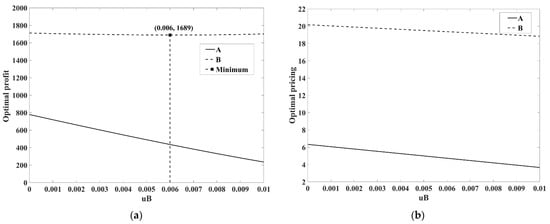
Figure 3.
Analysis results under the NS situation: (a) the optimal profit; (b) the optimal pricing.
4.3. Market Size Analysis
In this section, we set , , .
- 1.
- Scenario
Figure 4 describes the impact of increasing market size on the optimal profit and the optimal pricing of suppliers A and B in scenario . We found that the optimal pricing declines linearly with the market size increase, but suppliers A and B’s optimal pricing declines at different rates. According to the optimal pricing in Table 4, it is known that the declining rate of the optimal pricing is determined by the network effect of the value-added services. The larger the network effect, the lower the declining rate of the optimal pricing, which means the larger the network effect is, the less sensitive the supplier is to changes in the market size. In the same market size, the difference between the optimal pricing is determined by both the intrinsic value of the value-added service and the marginal cost of the hydrogen energy. The higher the intrinsic value of the supplier’s value-added service and the higher the marginal cost of the hydrogen energy, the higher the optimal pricing.
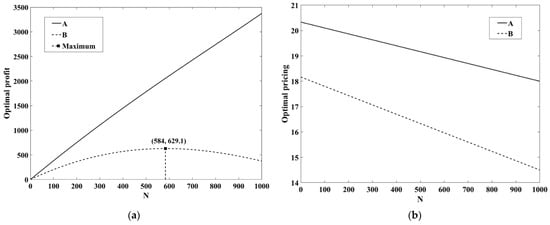
Figure 4.
Analysis results under scenario : (a) the optimal profit; (b) the optimal pricing.
Although the optimal prices are both decreasing, the trend of the profits of the two suppliers is different. Because the intrinsic value of supplier A satisfies the condition in Result 5, the optimal profit increases with the increase of the market size. Supplier B satisfies Result 5 only when , so its optimal profit increases first and then decreases, achieving a maximum at . It is mainly due to the increasing demand for the supplier that has an advantage in the intrinsic value of value-added services and network effects in the process of price reduction. According to the results in Figure 4a, it can be found that the expansion of the market size in the early stage has brought an increase in profits to both suppliers. Still, when the size increases to a certain level, B’s market is quickly replaced by A’s, and the profit begins to decline.
- 2.
- Scenario
Figure 5 describes the changes in the optimal profits and the optimal pricing of the two suppliers in scenario . From the perspective of the optimal pricing, supplier B’s optimal pricing is much lower than supplier A’s since it does not provide value-added services. Moreover, as the market size expands, the declining rate of the optimal pricing is also lower than that in scenario . It is due to the lack of market competition, which causes suppliers to be in an oligopolistic position in the provision of value-added services and are unwilling to reduce prices to obtain higher profits significantly. In particular, the difference can be seen in the optimal profit. For the parameters satisfying Result 6, the optimal profit of supplier A increases as the market size increases, and the profit of supplier A in scenario is much higher than that in scenario . In contrast, the optimal profit of supplier B is slightly lower than that in scenario . We find that supplier B’s intrinsic value of value-added services and network effects in scenario is lower than supplier A’s. Still, the loss of customers is not much different from scenario , so it is mainly due to the loss of pricing power resulting in lower profit.
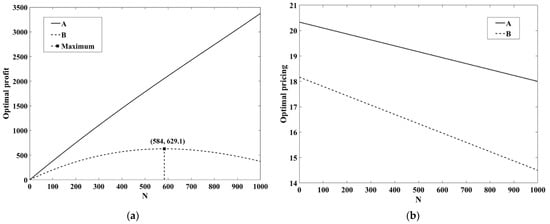
Figure 5.
Analysis results under scenario : (a) the optimal profit; (b) the optimal pricing.
- 3.
- Scenario ;
Figure 6 describes the changes of the optimal profit and the optimal pricing of the two suppliers in scenario . The difference from scenario is that supplier B, which provides value-added services at this time, has a smaller intrinsic value and network effect of value-added services. Supplier B obtains the pricing power due to its oligopolistic position, and its optimal pricing is much higher than that of supplier A. According to Result 7, the optimal profit of supplier B increases with the increase of the market size. Due to the smaller intrinsic value and network effect, supplier B’s optimal profit in scenario is lower than supplier A’s in scenario in terms of quantity and growth rate.
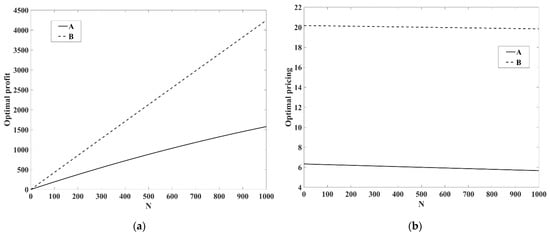
Figure 6.
Analysis results under scenario : (a) the optimal profit; (b) the optimal pricing.
- 4.
- Scenario ;
Figure 7 describes the changes of the optimal profits and the optimal pricing of the two suppliers in scenario . Under the circumstance that the network effects of the two suppliers are the same, we find that the decline in optimal pricing in scenario is consistent with that in scenario . When the network effects are the same, the competition between the two suppliers becomes more intense. This homogeneous and vicious competition causes suppliers to engage in price wars to gain each other’s market, but this is positive for consumers. Therefore, at the same market size, the profits of the two suppliers are lower than that in scenario , and the increase in the optimal profit also appears to be weaker.
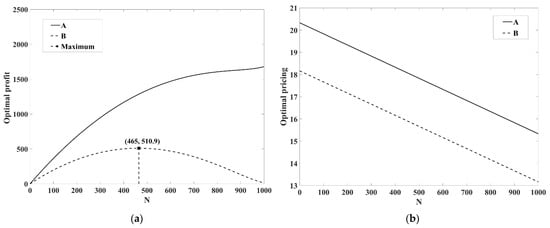
Figure 7.
Analysis results under scenario : (a) the optimal profit; (b) the optimal pricing.
4.4. Sales Strategy Analysis
This section selected two hydrogen energy suppliers in Shanghai, China as a simulation case. The quality of hydrogen energy provided by these two suppliers is the same, but the marginal cost is different. In order to broaden the business scenario, both suppliers consider providing value-added services, but the content and scope of the services are different. In order to analyze whether there is a need for these two suppliers to provide value-added services, we conduct an example analysis based on the model constructed in this paper, and the analysis process is shown in Figure 8. The input parameters for the two suppliers are shown in Table 8. According to the calculation result in Table 9, and , so both suppliers A and B should provide value-added services.
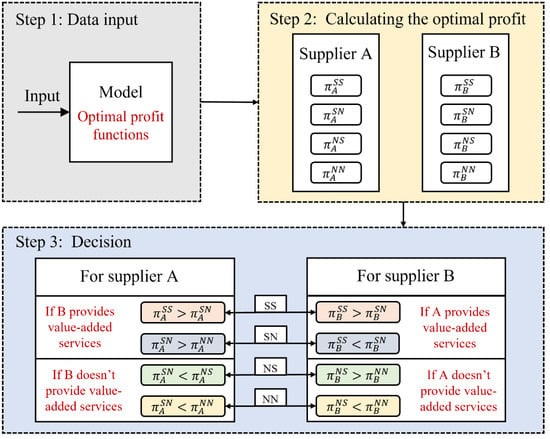
Figure 8.
The decision sequence for hydrogen energy suppliers.

Table 8.
The input parameters for the simulation case.

Table 9.
Calculation results of hydrogen energy suppliers’ optimal profits in different situations.
Furthermore, to facilitate supplier judgment, we directly calculated the parameter space of suppliers A and B regarding the intrinsic value of value-added services, as shown in Figure 9. It describes the strategy selection of the two hydrogen energy suppliers in the , parameter space. Where areas I, II, III, and IV represent SS, SN, NS, and NN market strategy equilibrium, respectively. The conditions of area I are and ; the conditions of area II are and ; the conditions of area III are and ; the conditions of area IV are and . The straight line in Figure 9 represents =, that is, the intrinsic value of value-added services of suppliers A and B are the same.
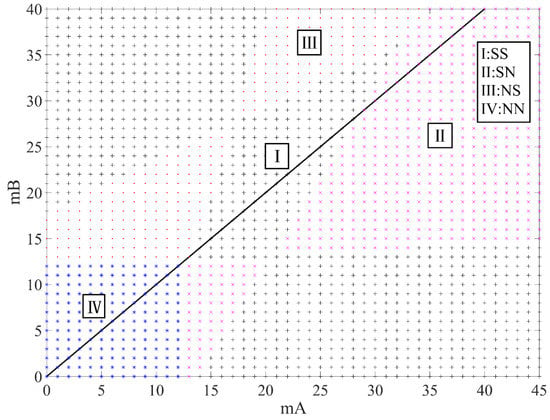
Figure 9.
Sales strategy equilibrium of hydrogen energy suppliers in the , parameter space.
When the intrinsic value of the value-added services of the two suppliers is low, it is a better choice not to provide value-added services because the profit from the sale of hydrogen energy is higher than the value-added services. When the intrinsic value of the value-added services is greater than a certain threshold, the choice to provide value-added services may bring higher profits to the hydrogen energy suppliers. Under the conditions set in this section, when (i.e., below the straight line) and is greater than a certain threshold (i.e., exceeding the area IV), supplier A should provide value-added services (i.e., areas I and II below the straight line). Moreover, when (i.e., above the straight line) and is greater than a certain threshold (i.e., exceeding the area IV), supplier B should also provide value-added services in most cases when the is small (i.e., areas I and III above the straight line), but should choose not to provide value-added services when the is relatively large (Region IV). The reason for this difference is that the network effect of supplier B’s value-added services is smaller than that of supplier A.
5. Conclusions
This study developed a two-stage sales strategy model for hydrogen energy and its value-added services based on the Hotelling model considering consumer network effects and preferences. It aimed to verify that hydrogen energy suppliers can improve their economic efficiency by introducing valued-added services that can activate the hydrogen energy market and form an effective market incentive. The following conclusions are drawn:
- (1)
- A hydrogen energy supplier’s provision of value-added services does not necessarily increase its profits. Only when the intrinsic value of its value-added services exceeds a certain threshold its profits will increase, and the threshold varies in different scenarios;
- (2)
- The profit of a hydrogen energy supplier is affected by four key factors: the intrinsic value of value-added services, the network effect of value-added services, the size of consumers, and the sales strategies of competitors. When the intrinsic value of value-added services is higher than the threshold, the profit of the hydrogen energy supplier increases with the increase of its service network effect and consumer network size but decreases with the increase of competitors’ value-added services network effects. When the intrinsic value of value-added services is lower than the threshold, it shows the opposite trend.
- (3)
- When the two hydrogen energy suppliers both provide value-added services, their profits will decrease with the increase of value-added service network effects, independent of the intrinsic value of the value-added services, so hydrogen energy suppliers should avoid vicious competition in the value-added services market. Finally, this paper obtains the optimal sales strategies for two suppliers in a specific scenario with the different intrinsic values of value-added services, which is quite practical for the application in a practical scenario.
In addition, some limitations in this paper need further improvement. On the one hand, this paper only studies the case of two oligopolistic hydrogen energy suppliers in the market. When there are multiple hydrogen energy suppliers in the market, the analysis can be performed by combining other hydrogen energy suppliers into one competitor. However, the computational volume of model solving will increase significantly with more market players, and such problems will be solved with the help of intelligent algorithms in the future. On the other hand, quantitatively analyzing the intrinsic value and network effects of value-added services and analyzing the market equilibrium problem when value-added services are compatible will be the focus of our and other scholars’ research in the future.
Author Contributions
Conceptualization, W.Z. (Wenhui Zhao), J.M., Z.W. and Y.L.; methodology, J.M.; software, J.M; formal analysis, J.M.; data curation, J.M., Z.W. and W.Z. (Weishi Zhang); writing—original draft preparation, J.M.; writing—review and editing, W.Z. (Wenhui Zhao), J.M. and Z.W.; visualization, J.M.; supervision, W.Z. (Wenhui Zhao); project administration, W.Z. (Wenhui Zhao); funding acquisition, W.Z. (Wenhui Zhao). All authors have read and agreed to the published version of the manuscript.
Funding
This research was funded by the National Social Science Foundation of China, grant number 20BJL036 and the Humanities and Social Science Fund of Ministry of Education of China, grant number 18YJAZH138.
Institutional Review Board Statement
Not applicable.
Informed Consent Statement
Not applicable.
Data Availability Statement
Not applicable.
Conflicts of Interest
The authors declare no conflict of interest.
References
- Ceseña, E.A.M.; Mancarella, P. Energy systems integration in smart districts: Robust optimisation of multi-energy flows in integrated electricity, heat and gas networks. IEEE Trans. Smart Grid 2018, 10, 1122–1131. [Google Scholar] [CrossRef]
- International Renewable Energy Agency. Hydrogen from Renewable Power: Technology Outlook for the Energy Transition. Available online: https://irena.org/publications/2018/Sep/Hydrogen-from-renewable-power (accessed on 20 February 2020).
- Han, X.; Zhang, X.H.; Yan, H.G.; Kang, J.D.; Li, J.H.; Zhang, H. Current Situation and Prospect of Global Hydrogen Energy Industry Policy. Electr. Power Inf. Commun. Technol. 2021, 19, 27–34. [Google Scholar] [CrossRef]
- Strategy & Middle East—PwC. The Dawn of Green Hydrogen: Maintaining the GCC’s Edge in a Decarbonized World. Available online: https://www.strategyand.pwc.com/m1/en/reports/2020/the-dawn-of-green-hydrogen/the-dawn-of-green-hydrogen.pdf (accessed on 15 March 2022).
- IEA. Global Hydrogen Review 2021. Available online: https://www.iea.org/reports/global-hydrogen-review-2021 (accessed on 15 March 2022).
- Kakoulaki, G.; Kougias, I.; Taylor, N.; Dolci, F.; Moya, J.; Jäger-Waldau, A. Green hydrogen in Europe–A regional assessment: Substituting existing production with electrolysis powered by renewables. Energy Convers. Manag. 2021, 228, 113649. [Google Scholar] [CrossRef]
- Hydrogen Council. Hydrogen Insights–A Perspective on Hydrogen Investment, Market Development and Cost Competitiveness. Available online: http://www.stdlibrary.com/p-1368016.html (accessed on 26 February 2021).
- Fuel Cells and Hydrogen. Hydrogen Roadmap Europe: A Sustainable Pathway for the European Energy Transition. Available online: https://www.fch.europa.eu/sites/default/files/Hydrogen%20Roadmap%20Europe_Report.pdf (accessed on 10 February 2021).
- Wang, Y.Y.; Gao, L.; Liu, Y.D. The Inspiration of the National Hydrogen Energy Roadmap of US. Future Dev. 2015, 39, 22–29. [Google Scholar]
- Fu, G.Y.; Xiong, H.W. The models of hydrogen energy development in Japan, Germany and the United States and enlightenments. Macroecon. Manag. 2020, 6, 84–90. [Google Scholar] [CrossRef]
- Bao, J.C.; Zhao, Z.L.; Ma, Q.Y. Overview of the development trends of hydrogen energy technologies. Automot. Dig. 2020, 2, 6–11. [Google Scholar] [CrossRef]
- Xia, F.J.; Zhou, Y. Current status and perspective of hydrogen energy and fuel cell technologies in Germany. Mar. Electr. Electr. Eng. 2015, 35, 49–52. [Google Scholar] [CrossRef]
- Ding, M. Characteristics, motivation, international coordination of Japan’s hydrogen strategy. Contemp. Econ. Jpn. 2021, 4, 28–41. [Google Scholar] [CrossRef]
- Wang, L.; Cao, Y. Utilization of hydrogen energy and its enlightenment to China’s development. Shanghai Energy Conserv. 2021, 5, 444–448. [Google Scholar] [CrossRef]
- Chung, Y.; Hong, S.; Kim, J. Which of the technologies for producing hydrogen is the most prospective in Korea?: Evaluating the competitive priority of those in near-, mid-, and long-term. Energy Policy 2014, 65, 115–125. [Google Scholar] [CrossRef]
- Lee, B.; Chae, H.; Choi, N.H.; Moon, C.; Moon, S.; Lim, H. Economic evaluation with sensitivity and profitability analysis for hydrogen production from water electrolysis in Korea. Int. J. Hydrogen Energy 2017, 42, 6462–6471. [Google Scholar] [CrossRef]
- Hartley, P.G.; Au, V. Towards a Large-Scale Hydrogen Industry for Australia. Engineering 2020, 6, 1346–1348. [Google Scholar] [CrossRef]
- Andreasen, K.P.; Sovacool, B.K. Energy sustainability, stakeholder conflicts, and the future of hydrogen in Denmark. Renew. Sustain. Energy Rev. 2014, 39, 891–897. [Google Scholar] [CrossRef]
- Nikolaidis, P.; Poullikkas, A. A comparative overview of hydrogen production processes. Renew. Sustain. Energy Rev. 2017, 67, 597–611. [Google Scholar] [CrossRef]
- Acar, C.; Beskese, A.; Temur, G.T. Sustainability analysis of different hydrogen production options using hesitant fuzzy AHP. Int. J. Hydrogen Energy 2018, 43, 18059–18076. [Google Scholar] [CrossRef]
- Huang, Y.S.; Liu, S.J. Efficiency evaluation of a sustainable hydrogen production scheme based on super efficiency SBM model. J. Clean. Prod. 2020, 256, 120447. [Google Scholar] [CrossRef]
- Muthurasu, A.; Ojha, G.P.; Lee, M.; Kim, H.Y. Zeolitic imidazolate framework derived Co3S4 hybridized MoS2–Ni3S2 heterointerface for electrochemical overall water splitting reactions. Electrochim. Acta 2020, 334, 135537. [Google Scholar] [CrossRef]
- Muthurasu, A.; Ojha, G.P.; Lee, M.; Kim, H.Y. Integration of cobalt metal–organic frameworks into an interpenetrated prussian blue analogue to derive dual metal–organic framework-assisted cobalt iron derivatives for enhancing electrochemical total water splitting. J. Phys. Chem. C 2020, 124, 14465–14476. [Google Scholar] [CrossRef]
- Huo, X.X.; Wang, J.; JIang, L.; Xu, Q.S. Review on key technologies and applications of hydrogen energy storage system. Energy Storage Sci. Technol. 2016, 5, 197–203. [Google Scholar]
- Wan, C.; Zhou, L.; Xu, S.M.; Jin, B.Y.; Ge, X.; Qian, X.; Xu, L.X.; Chen, F.Q.; Zhan, X.L.; Yang, Y.R. Defect engineered mesoporous graphitic carbon nitride modified with AgPd nanoparticles for enhanced photocatalytic hydrogen evolution from formic acid. Chem. Eng. J. 2022, 429, 132388. [Google Scholar] [CrossRef]
- Ren, Z.H.; Zhang, X.; Gao, M.X.; Pan, H.G.; Liu, Y.F. Research Progress in Ti-Based Catalysts-Modified NaAIH4 Hydrogen Storage Materials. Chin. J. Rare Met. 2021, 45, 569–582. [Google Scholar] [CrossRef]
- Burkhardt, J.; Patyk, A.; Tanguy, P.; Retzke, C. Hydrogen mobility from wind energy–A life cycle assessment focusing on the fuel supply. Appl. Energy 2016, 181, 54–64. [Google Scholar] [CrossRef]
- Xu, S.S.; Zhang, R.Y.; Cheng, J.; Wang, H.J.; Lu, C.Z. Application and development of electrolytic hydrogen production and high temperature fuel cell in electric power industry. Proc. CSEE 2019, 39, 2531–2537. [Google Scholar] [CrossRef]
- Li, J.R.; Lin, J.; Song, Y.H.; Xing, X.T.; Fu, C. Operation optimization of power to hydrogen and heat (P2HH) in ADN coordinated with the district heating network. IEEE Trans. Sustain. Energy 2018, 10, 1672–1683. [Google Scholar] [CrossRef]
- Grube, T.; Doré, L.; Hoffrichter, A.; Hombach, L.E.; Raths, S.; Robinius, M.; Nobis, M.; Schiebahn, S.; Tietze, V.; Schnettler, A. An option for stranded renewables: Electrolytic-hydrogen in future energy systems. Sustain. Energy Fuels 2018, 2, 1500–1515. [Google Scholar] [CrossRef]
- Parra, D.; Valverde, L.; Pino, F.J.; Patel, M.K. A review on the role, cost and value of hydrogen energy systems for deep decarbonisation. Renew. Sustain. Energy Rev. 2019, 101, 279–294. [Google Scholar] [CrossRef]
- Ju, H.; Badwal, S.; Giddey, S. A comprehensive review of carbon and hydrocarbon assisted water electrolysis for hydrogen production. Appl. Energy 2018, 231, 502–533. [Google Scholar] [CrossRef]
- Hosseini, S.E.; Wahid, M.A. Hydrogen production from renewable and sustainable energy resources: Promising green energy carrier for clean development. Renew. Sustain. Energy Rev. 2016, 57, 850–866. [Google Scholar] [CrossRef]
- Phoumin, H.; Kimura, F.; Arima, J. Potential renewable hydrogen from curtailed electricity to decarbonize ASEAN’s emissions: Policy implications. Sustainability 2020, 12, 10560. [Google Scholar] [CrossRef]
- Rosen, M.A.; Koohi-Fayegh, S. The prospects for hydrogen as an energy carrier: An overview of hydrogen energy and hydrogen energy systems. Energy Ecol. Environ. 2016, 1, 10–29. [Google Scholar] [CrossRef] [Green Version]
- Soinio, J.; Tanskanen, K.; Finne, M. How logistics-service providers can develop value-added services for SMEs: A dyadic perspective. Int. J. Logist. Manag. 2012, 23, 31–49. [Google Scholar] [CrossRef]
- Dan, B.; Zhang, S.G.; Zhou, M.S. Strategies for warranty service in a dual-channel supply chain with value-added service competition. Int. J. Prod. Res. 2018, 56, 5677–5699. [Google Scholar] [CrossRef]
- Yi, S.M.; Yu, L.Y.; Zhang, Z.Y. Research on Pricing Strategy of Dual-Channel Supply Chain Based on Customer Value and Value-Added Service. Mathematics 2021, 9, 11. [Google Scholar] [CrossRef]
- Li, K.P.; Mu, Q.T.; Wang, F.; Gao, Y.J.; Li, G.; Shafie-Khah, M.; Catalão, J.P.; Yang, Y.C.; Ren, J.F. A business model incorporating harmonic control as a value-added service for utility-owned electricity retailers. IEEE Trans. Ind. Appl. 2019, 55, 4441–4450. [Google Scholar] [CrossRef]
- Dou, G.W.; He, P.; Xu, X. One-side value-added service investment and pricing strategies for a two-sided platform. Int. J. Prod. Res. 2016, 54, 3808–3821. [Google Scholar] [CrossRef]
- Wang, W. Study on technology commercialization strategies of the innovator in the presence of network Effects. Soft Sci. 2020, 34, 90–96. [Google Scholar] [CrossRef]
- Chen, N.Y.; Chen, Y.J. Duopoly competition with network effects in discrete choice models. Oper. Res. 2021, 69, 545–559. [Google Scholar] [CrossRef]
- Nie, L.; Wang, X.J. Complementary two-sided platforms’ advertising decision Problem based on hoteling Model. J. Tianjin Univ. 2021, 23, 20–24. [Google Scholar]
- Lv, K.; Hu, H.H.; Wang, X.H. Bundling competition with scope economics and switching costs. J. Manag. Sci. China 2012, 15, 10–24. [Google Scholar]
- Li, X.X.; Chen, Y.X. Corporate IT standardization: Product compatibility, exclusive purchase commitment, and competition effects. Inf. Syst. Res. 2012, 23, 1158–1174. [Google Scholar] [CrossRef]
Publisher’s Note: MDPI stays neutral with regard to jurisdictional claims in published maps and institutional affiliations. |
© 2022 by the authors. Licensee MDPI, Basel, Switzerland. This article is an open access article distributed under the terms and conditions of the Creative Commons Attribution (CC BY) license (https://creativecommons.org/licenses/by/4.0/).